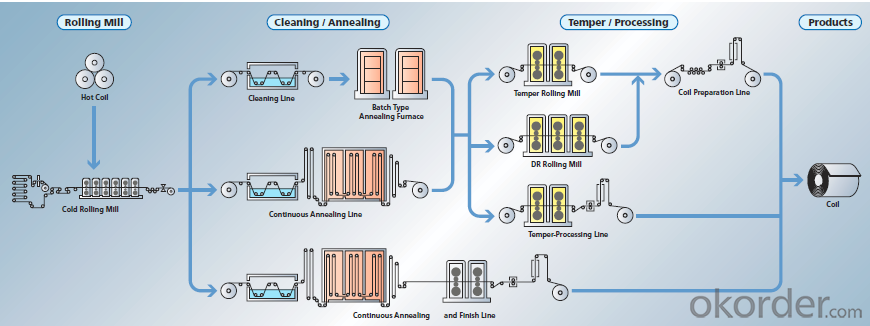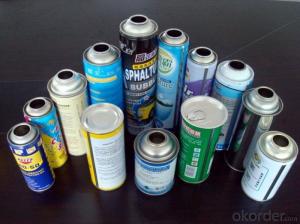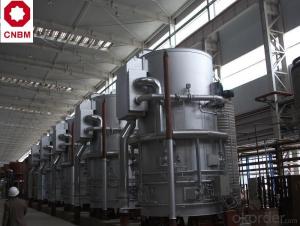Prime GradeTinplate For Aerosol Cans, MR,
- Loading Port:
- Tianjin
- Payment Terms:
- TT OR LC
- Min Order Qty:
- 50 m.t.
- Supply Capability:
- 40000 m.t./month
OKorder Service Pledge
OKorder Financial Service
You Might Also Like
1.Brief Introduction
Tinplate is widely used for making all types of containers, containing industrial usage such as paint can, oil can, aerosol cans etc., and food cans like milk powder cans, tomato paste can, dry food cans etc.
2. Quality
As a state owned company and a large tinplate supplier in China, our tinplate quality ranks 1st level in China, similar to Bao Steel, Posco etc.
3. Specification
standard: GB/T2520, JIS G3303, DIN EN10202
Material: MR /SPCC
Thickness available: 0.16-0.50MM
Width available: 600~1050MM
Temper grade: T1 – DR8
Tin coating: ordinary 2.8g/2.8g, 5.6g/5.6g and others
Package: sea worthy export package.
Applications: Tin can for chemicals & paint cans, industrial cans, food cans
4. Our production steps

5. Usage Scope

6. Our euxport market
our tinplate has been popularly exported to more than 30 countries, including Asia, Europe countries, Gulf area, Sounth America, Northe & South Afric etc.
- Q:How does tinplate perform in terms of moisture resistance?
- Tinplate performs exceptionally well in terms of moisture resistance. The tin coating on the surface acts as a protective barrier, preventing moisture from coming into contact with the underlying metal. This makes tinplate highly resistant to corrosion and oxidation caused by moisture, ensuring the product's durability and longevity.
- Q:How does tinplate contribute to the preservation of photographic equipment?
- Tinplate contributes to the preservation of photographic equipment by providing a durable and corrosion-resistant material for the construction of camera bodies and other components. This helps protect the sensitive internal mechanisms from external factors such as moisture, dust, and physical damage, thereby extending the lifespan of the equipment. Tinplate also helps maintain the overall aesthetic appeal of the equipment, as it can be easily coated or painted to enhance its appearance and protect it from scratches or wear.
- Q:How does tinplate compare to glass in terms of packaging applications?
- Tinplate has several advantages over glass in terms of packaging applications. Firstly, tinplate is much lighter than glass, making it easier and cheaper to transport. Additionally, tinplate is more durable and less prone to breakage than glass, reducing the risk of product damage during handling and shipping. Moreover, tinplate provides a better barrier against air, moisture, and light, ensuring the preservation and quality of the packaged goods. Lastly, tinplate is more cost-effective than glass, making it a preferred choice for many packaging applications.
- Q:What are the common labeling options for tinplate containers?
- The common labeling options for tinplate containers include adhesive labels, heat transfer labels, direct printing, and embossing.
- Q:What are the different ways to seal tinplate containers?
- There are several different ways to seal tinplate containers, including using a screw-on cap, a snap-on lid, a crimped or rolled edge, a heat-sealed liner, or a combination of these methods.
- Q:How do you clean the dust and trace oil on tin containers?
- Solvent cleaning: This is the traditional way, from the middle of the Qing Dynasty period have been used, it is with a cleaning agent such as solvent, steam coal, white oil (to waterlogging, water purifier, hydrocarbon and so on).
- Q:What are the common sealing options for tinplate containers?
- Some common sealing options for tinplate containers include twist-off caps, lug caps, press-on caps, and peel-off lids.
- Q:How does tinplate contribute to the circular economy in the steel industry?
- Tinplate contributes to the circular economy in the steel industry by being a highly recyclable material. It can be easily recovered and reused, reducing the need for extracting new resources. Additionally, tinplate's durability and corrosion resistance properties make it suitable for multiple uses, further extending its lifecycle and minimizing waste.
- Q:How does tinplate perform in terms of resistance to mechanical stress?
- Tinplate performs well in terms of resistance to mechanical stress. Its sturdy and durable nature allows it to withstand various forms of mechanical stress such as bending, twisting, or impact. Additionally, the tin coating on the surface provides an added layer of protection, enhancing its resistance to corrosion and further strengthening its ability to withstand mechanical stress.
- Q:What are the common closure options for tinplate containers?
- The common closure options for tinplate containers include twist-off caps, screw caps, snap-on lids, and pressure-sealed lids.
1. Manufacturer Overview |
|
|---|---|
| Location | |
| Year Established | |
| Annual Output Value | |
| Main Markets | |
| Company Certifications | |
2. Manufacturer Certificates |
|
|---|---|
| a) Certification Name | |
| Range | |
| Reference | |
| Validity Period | |
3. Manufacturer Capability |
|
|---|---|
| a)Trade Capacity | |
| Nearest Port | |
| Export Percentage | |
| No.of Employees in Trade Department | |
| Language Spoken: | |
| b)Factory Information | |
| Factory Size: | |
| No. of Production Lines | |
| Contract Manufacturing | |
| Product Price Range | |
Send your message to us
Prime GradeTinplate For Aerosol Cans, MR,
- Loading Port:
- Tianjin
- Payment Terms:
- TT OR LC
- Min Order Qty:
- 50 m.t.
- Supply Capability:
- 40000 m.t./month
OKorder Service Pledge
OKorder Financial Service
Similar products
New products
Hot products
Related keywords



























